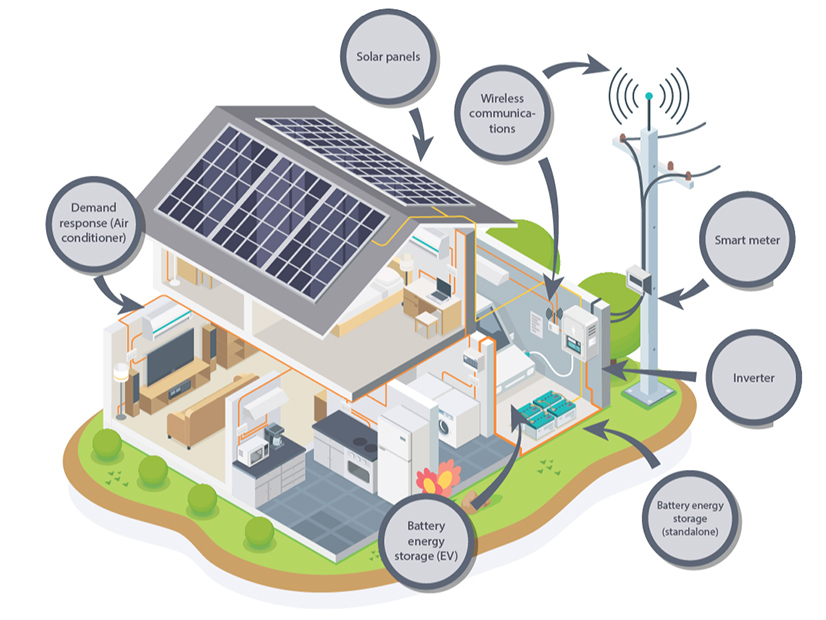ALBANY, N.Y. — NYISO on Tuesday explained that its proposal to set a 10-kW minimum for distributed energy resource participation in an aggregation is necessary because the ISO’s software is not up-to-date and staff lack the capacity to audit potentially hundreds of individual DERs.
Harris Eisenhardt, NYISO market design specialist, told stakeholders allowing DERs of less than 10 kW would “require substantial amount of additional manual work” to complete the tasks to evaluate aggregation participation.
Staff are required to review the physical characteristics of DER applicants — which sometimes requires a site visit — verify proposed operational parameters and coordinate interconnection with distribution utilities, said Eisenhardt.
Software updates will eventually be able to automate many of these tasks, but NYISO has experienced unexpected delays, as it told FERC in its recently accepted extension request for Order 2222 compliance. (See FERC Gives NYISO Until 2026 to Complete Order 2222 Compliance.)
Stakeholders continued expressing displeasure with the proposal, claiming the requirement would exclude residential storage resources, ran counter to both FERC’s and the ISO’s objectives for DERs and placed barriers to aggregation participation. (See NYISO 10-kW Min for DER Aggregation Participation Riles Stakeholders.)
Aaron Breidenbaugh, director of regulatory affairs at CPower Energy Management, said he was concerned that the proposal “excludes all residential participation” and that there was no indication that the ISO would make any meaningful changes in the future.
Christopher Hall, of the New York State Energy Research and Development Authority, argued against the proposal, saying it “shuts out residential storage assets from participating because the average size of such assets is around 7 or 8 kW.” He asked the ISO where the 10-kW figure came from.
Eisenhardt responded that the number was the result of internal analysis and was set at the current threshold to “better understand initial penetration” of DERs and, considering NYISO’s incrementally based systems, the 10-kW value was seen as the “logical next step from 1 kW.”
Peter Fuller, on behalf of Sunrun, said NYISO is “misapprehending what Order 2222 is asking for,” and that the “administrative concerns” raised by the ISO could be solved with a change of mindset that focuses on enabling aggregations consistent of every resource.
Eisenhardt responded that NYISO appreciates stakeholders’ concerns, but he maintained that the proposed requirement would help the ISO get everything in place in a timely manner and ensure that the resources necessary to manage the initial set of DERs are in place.
One stakeholder asked why setting a lower minimum threshold, such as 5 kW, warranted software updates that would delay deployment.
James Pigeon, DER integration manager at NYISO, said the ISO is still unsure about how to treat differently structured aggregations and was not prepared to undertake additional manual bandwidth to evaluate individual, smaller-scale DERs.
Pigeon also said the ISO is not trying to shut the conversation down but is looking to get out the FERC-accepted model, learn more about initial DER deployment and avoid further delays in implementation. Pigeon told stakeholders that because NYISO now operates on a 2026 deployment timeline, there is still opportunity to find workable solutions.
Breidenbaugh told NYISO that it would be helpful if the ISO made tangible commitments to exploring more solutions, which Fuller followed up on by saying that without commitments to eliminate the proposed minimum, it will be hard for stakeholders to make future decisions or investments with confidence.
NYISO will present the draft tariff language at the Installed Capacity Working Group/Market Issues Working Group meeting Tuesday to seek approval from the Business Issues Committee and Management Committee in January.
Capacity Accreditation
 Revised capacity accreditation saves $390 million in capacity market procurement costs | NYISO
Revised capacity accreditation saves $390 million in capacity market procurement costs | NYISO
NYISO presented a timeline for the assignment of capacity accreditation factors (CAFs) and capacity accreditation resource classes (CARCs); implementation begins August 2023, and the first auction for the upcoming capability year starts in May 2024.
NYISO will post the CAFs for each CARC for the upcoming capability year to its website by March 1.
An updated consumer impact analysis the ISO is conducting on its proposed capacity accreditation method found that a revised analysis based on the recent 2022 Reliability Needs Assessment saved $390 million in capacity procurement costs when compared to existing approaches. (See “Capacity Accreditation of ‘Performance-based’ Resources,” NYISO Installed Capacity Working Group/Market Issues Working Group Briefs: Sept. 30, 2022.)



